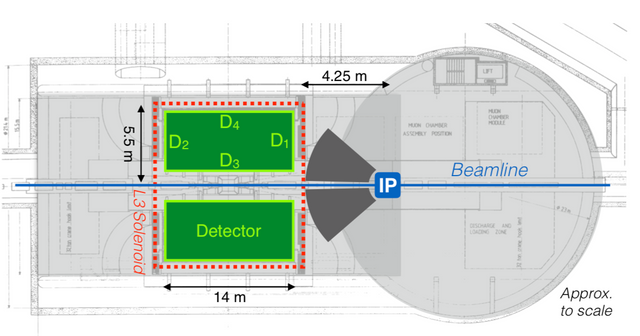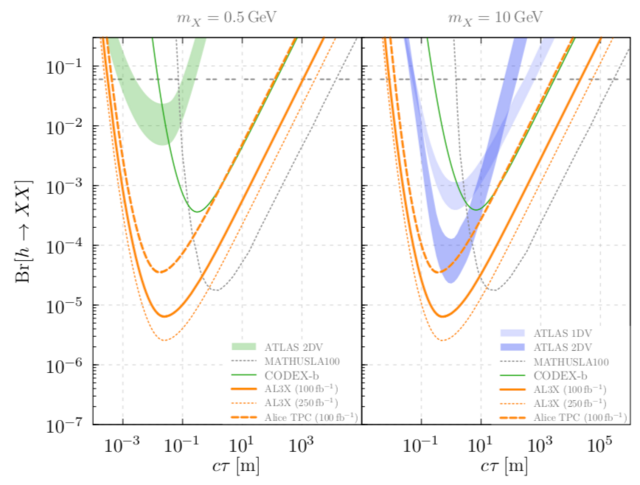Probing long-lived particles at the LHC with AL3X
The Standard Model of particle physics belongs to the most tested theoretical frameworks of all time. Thousands of measurements have been made, and it turns out that data and theoretical predictions agree to a large extent.
 [image credits: geralt (CC0)]
[image credits: geralt (CC0)] However, it is widely established that the Standard Model is not the end of the story, and there are thus damned good reasons to investigate what lies beyond it.
As a consequence, the hunt for new phenomena is a key challenge of all on-going and future high-energy physics experiments.
Long-lived particles not present in the Standard Model belongs to the category of well-motivated candidates for new phenomena. Especially as these could explain the absence of any signal at the Large Hadron Collider at CERN.
Those long-lived particles can indeed not really be probed with the current experiments at our disposal, and are thus central in the design of future particle physics experiments. We do not want any loop-hole in our search program, so that these must be covered as soon as possible.
This is what I will discuss today: a new proposal for detecting those long-lived particles called AL3X.
LONG-LIVED PARTICLES
Many well-motivated theories extending the Standard Model of particle physics have a collider signature involving long-lived particles.

[image credits: Stinging eyes (CC BY-SA 2.0)]
By definition, a long-lived particle is a particle which, once produced, flies on a potentially long distance before undergoing any other reaction.
In other words, long-lived particles do not decay promptly and the next thing that will happen to them could be located far far away from the point where they have been produced.
Detectors like ATLAS or CMS have not been designed to catch these particles.
This class of detector indeed assumes that any new particle to be produced will instantaneously decay, and they lose efficiency when the particle lifetime increases. At some point, any hope to see anything is even gone.
Long-lived particles freshly produced at the LHC may hence decay further, at a place where it is much harder (and possibly impossible) to look at. Whilst the LHC detectors are optimal to observe what is going on close to the collision point at the center of the detector, they are by far not suitable for long-lived stuff.
A new strategy is thus in order.
NEW STRATEGIES WITH AL3X
Whilst not-too-long-lived long-lived particles can be seen with ATLAS and CMS, longer-long-lived guys requires something else to be detected. As we really want to be able to detect those particles if they exist (to understand how nature works at its most fundamental level), the high-energy physics community has then started to propose a various set of experiments dedicated to this task.
I have written on two of them in the past, SHiP and FASER. Here, I plan to describe a new option that has been recently proposed and that is called AL3X.
First, what does AL3X mean? Very importantly, it is not related to @alexdory or @alexs1320, our SteemSTEM’s Alexes (not too sure about the plural form of Alex). The AL3X I am writing about is an experiment whose name consists in an acronym standing for A Laboratory for Long-Lived eXotics. Yeah, physicists love acronyms and sometimes they are good (OK, not always).

[image credits: Inspire]
The idea here is to focus on the ALICE experiment that is expected to terminate before the end of the LHC operations. There may thus be options to use the ALICE location to build a new experiment, potentially addressing long-lived particles. On example is AL3X, whose idea is sketched in the above picture.
The interaction point (IP on the figure) is where LHC collisions occurs. The detector (in green) is shielded from the interaction point so that no known particle can reach it. There is thus a heavy shield (in dark grey) and a magnet (in red) between the detector and the interaction point. The goal of the shielding is to absorb any particle produced during the LHC collision.
Every particle? Of course not! By definition, long-lived particles do not care much, and can fly through the shield undisturbed, since they do not interact immediately after having been produced. From the picture, it is shown that long-lived particles flying up to 20 meters could be discovered.
Whilst quite simple, there is a catch. Currently, LHC collisions occur in the middle of the magnet (in red). Building AL3X would therefore require to move the location of the collisions. This is however not impossible, as this ‘only’ requires to reconfigure a few magnets (which has a cost to be evaluated).
In the meantime, it is important to start the physics studies to precisely get a grip on the physics potential of AL3X.
TLDR - HUNTING THE LONG-LIVED ONES
I described a new experiment that has been proposed for what concerns the future of the LHC. This experiment is called AL3X and has been discussed for the first time in this research article.
Long-lived particles appear in many models, and they are not really easy to detect with the current LHC detectors, for the very reason that they are long-lived. They indeed fly through the detectors and do not interact with them immediately, which renders their detection complicated.
As a consequence, physicists are proposing new experiments specifically dedicated to this class of new particles. The AL3X apparatus is one of them. It aims to make use of the cavern of an existing LHC experiment, ALICE, once this experiment will be terminated. The key idea is to shield the collision point from the detector so that only long-lived beasts could reach it (and be observed).

[image credits: Inspire]
An example of the physics potential of AL3X is illustrated on the picture on the left.
This represents the coverage of phenomena underlied by the exotic decays of the Higgs boson into a pair of long-lived particles X.
Focusing on two different masses for the particle X (very light on the left and more massive on the right), the green and blue areas represent the scenarios covered by the current LHC experiments, whilst the orange curves show the improvements expected thanks to AL3X.
Those improvement are huge!
Such a similar figure can be obtained for many models of physics featuring long-lived particles. As can be seen, the proposed AL3X experiment offer a great handle to discover long-lived guys, extending by several orders of magnitude what could be expected from the current LHC experiments.
STEEMSTEM
SteemSTEM aims to build a community of science lovers to make Steem a better place for Science Technology Engineering and Mathematics (STEM). We have recently released our own app, steemstem.io, and we run a witness to support the Steem blockchain.
More information can be found on the @steemstem blog (here for the latest news) and on our discord server.
We are on our way to make Steem a crucial medium for science communication, and it is still time to contribute to this effort! If you want to support us (and get some incentives for it), this is also possible.
My first time of hearing about long-lived particles in details.
I want to ask; what's the minimum distance a particle would have to travel from the point of production (without undergoing a reaction) for it to be qualified as a long-lived particle?
In general, new particle lifetimes are so small than the decay looks instantaneous from the detector standpoint. Any particle whose decay would be recorded as a displaced decay (compared to the primary collision point) can thus considered as long-lived.
Typically, from the LHC standards, we consider particles flying over distances ranging from millimeters to a couple of dozens of meters. Of course, long-lived particles could even be more long-lived ("stable" is the maximum).
You were right physicists love acronyms. But Al3X seems kinda funny. The person that crafted it from "A Laboratory for Long-Lived eXotics" should be given an award
I don't know who this person is exactly, but in the case I learn it, I will let him know ;)
You should
You can count on me ;)
I feel honoured :D
In biology, there are Alexa Fluor
https://en.wikipedia.org/wiki/Alexa_Fluor
Mmmh, do you know how did the name come from here? This is not indicated on the wikipedia page and google does not help...
You are world famous in all fields of research ^^
Would CERN be interested in a room to rent in Dublin for a new detector? :-)
It depends. Does it come with a powerful accelerator? :D
13 amps, that ok?
Sorry no. More powerful would be better. :D
“Why it's simply impassible!
Alice: "Why, don't you mean impossible?"
Door: "No, I do mean impassible. (chuckles) Nothing's impossible!”
lol! This was a funny one, and I haven't heard it before :) I will definitely reuse it ^^
After reading your article, it was the first thing that popped into my mind.
I am glad you shared it then ^^
Feel free to ask for questions if you have any (even on a slightly different, but connected, topic).
" (even on a slightly different, but connected, topic)."
I lol'd
Pure advanced science. Excellent work @lemouth. Regards.
Thanks a lot for passing by!
Hi @lemouth!
Your post was upvoted by utopian.io in cooperation with @steemstem - supporting knowledge, innovation and technological advancement on the Steem Blockchain.
Contribute to Open Source with utopian.io
Learn how to contribute on our website and join the new open source economy.
Want to chat? Join the Utopian Community on Discord https://discord.gg/h52nFrV